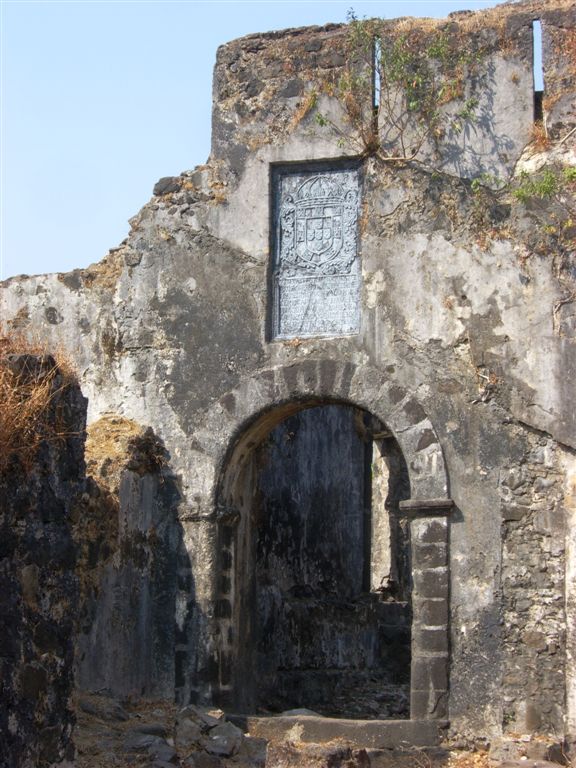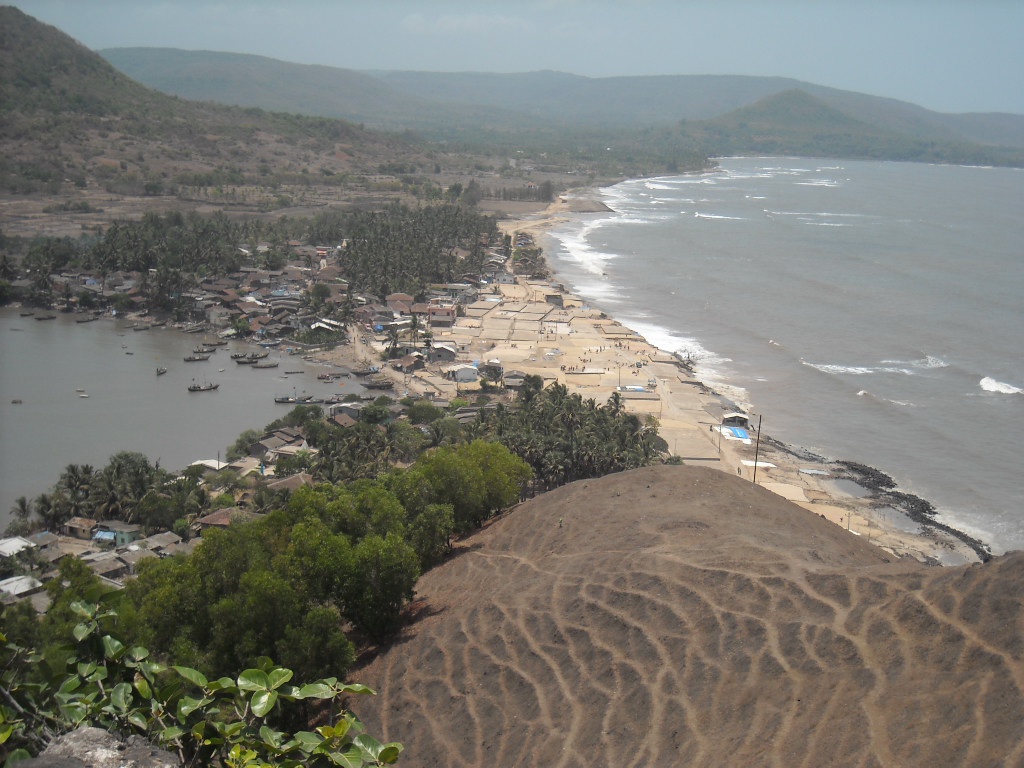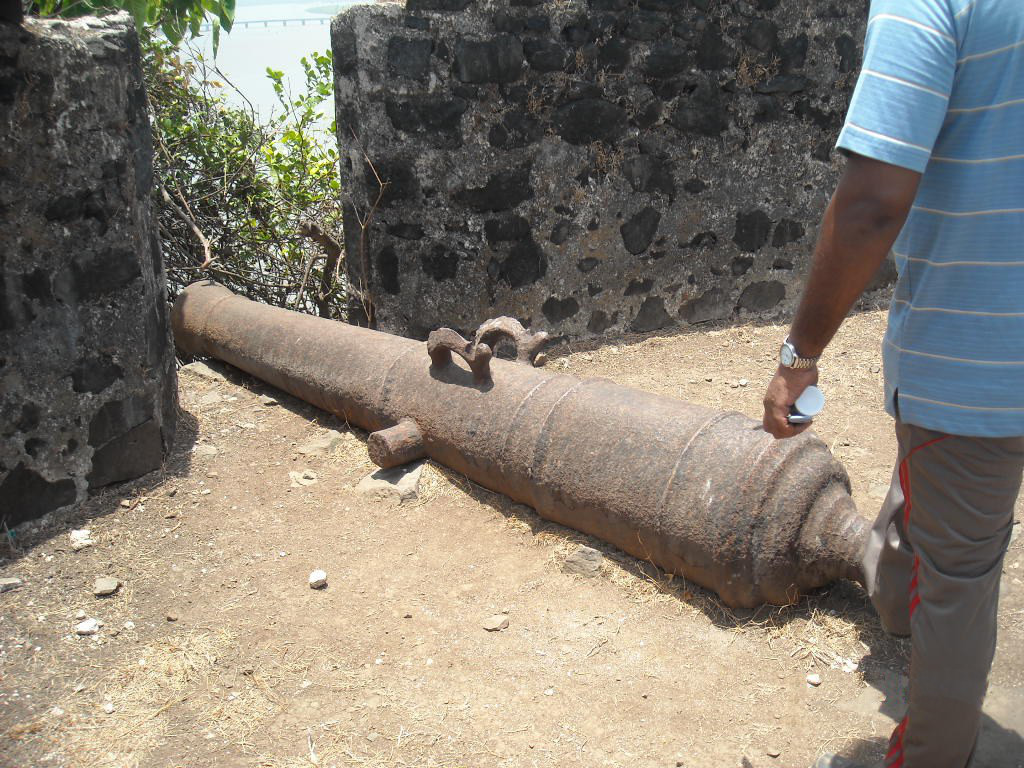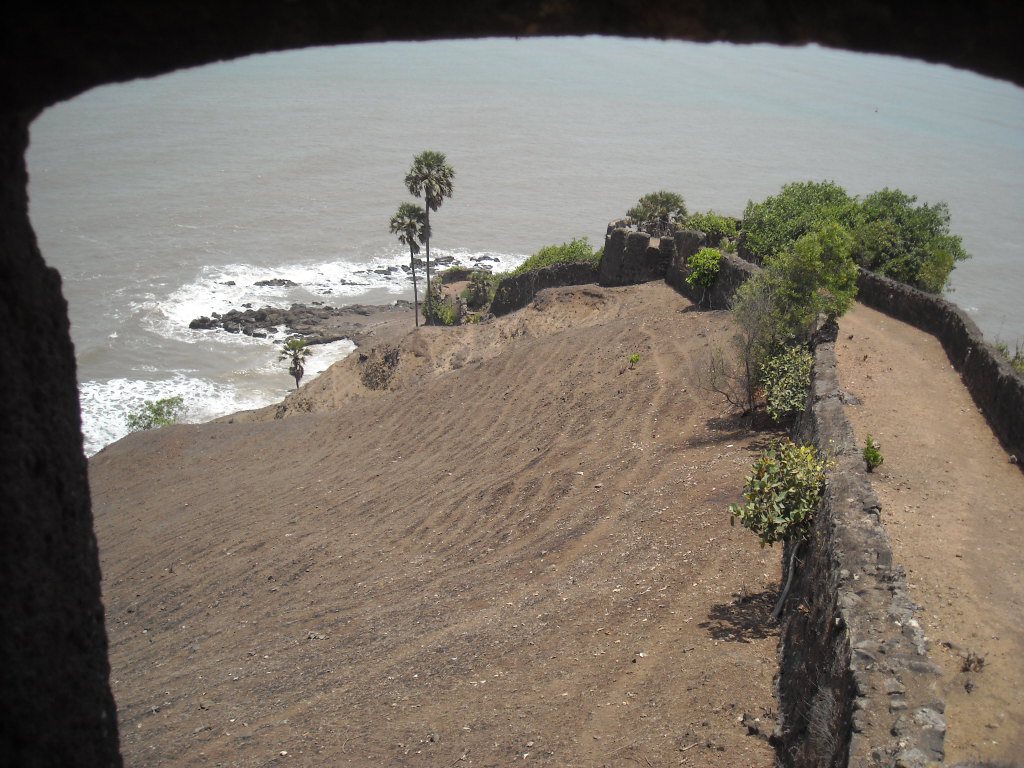Korlai Fort on:
[Wikipedia]
[Google]
[Amazon]
Korlai Fort is a colonial fort in the
 This fort was built in 1521 by the
This fort was built in 1521 by the







 The fort is 2828 feet long, and its average breadth is eighty-nine feet. The enclosing wall is 5' 3" high and has 305 battlements for guns. It is entered by eleven gates - four are outer and seven are inner. At the north point, within pistol-shot of main battery is the water cistern named Santa Cruz - major source of water. The area within the fort walls is divided into three enclosures by two lines of bastioned fortifications. Each of the seven bastions bears the name of a saint. The two westward bastions are named S√£o Diego(after
The fort is 2828 feet long, and its average breadth is eighty-nine feet. The enclosing wall is 5' 3" high and has 305 battlements for guns. It is entered by eleven gates - four are outer and seven are inner. At the north point, within pistol-shot of main battery is the water cistern named Santa Cruz - major source of water. The area within the fort walls is divided into three enclosures by two lines of bastioned fortifications. Each of the seven bastions bears the name of a saint. The two westward bastions are named S√£o Diego(after
Image:Korlai_fort_hall.jpg, Korali fort main hall ruins
Image:Korlai_fort_entrance.jpg, Korlai fort entrance
Image:Korlai fort walkway.jpg, Korlai fort walkway
Image:Korlai fort walkway2.jpg, The Inscription stone
Image:Korlai fort cross2.JPG, The Cross bateri
Raigad district
Raigad district (Marathi pronunciation: ĺaňźj…°…ô…Ė, previously Colaba district, is a district in the Konkan division of Maharashtra, India.
The district was renamed to Raigad after the fort that was the first capital of the former Marath ...
of Maharashtra
Maharashtra (; , abbr. MH or Maha) is a states and union territories of India, state in the western India, western peninsular region of India occupying a substantial portion of the Deccan Plateau. Maharashtra is the List of states and union te ...
, India. Formerly a part of the Chaul
Chaul is a historic town located in the Raigad district of Maharashtra, India. The Korlai Fort is located nearby.
History
The town was famous for cotton manufactured goods in the 15th and 16th century, According to Varthema, Chaul was prod ...
in Portuguese India
The State of India ( pt, Estado da √ćndia), also referred as the Portuguese State of India (''Estado Portugu√™s da √ćndia'', EPI) or simply Portuguese India (), was a state of the Portuguese Empire founded six years after the discovery of a se ...
, the structure is a specimen of Portuguese colonial architecture
Portuguese colonial architecture refers to the various styles of Portuguese architecture built across the Portuguese Empire. Portuguese colonial architecture can be found in the plethora of former colonies throughout South America, North Africa, S ...
. It was built as a companion to the fort at Chaul, at this strategic position the Portuguese could use it to defend their province which stretched from Korlai to the Fort Bassein
Fort Vasai (Fortaleza de São Sebastião de Baçaím) is a ruined fort of the town of Vasai (Bassein), Maharashtra, India. The structure was formally christened as the Fort of St. Sebastian in the Indo-Portuguese era. The fort is a monument ...
. Vestiges of the Portuguese occupation are manifested in the distinct dialect of the Korlai villages inhabitants which is a Luso-Indian
Luso-Indians or Portuguese-Indian, is a subgroup of the larger multiracial ethnic creole people of Luso-Asians. Luso-Indians are people who have mixed varied Indian subcontinent and European Portuguese ancestry or people of Portuguese descent ...
creole called Korlai Portuguese Creole.
History
 This fort was built in 1521 by the
This fort was built in 1521 by the Portuguese
Portuguese may refer to:
* anything of, from, or related to the country and nation of Portugal
** Portuguese cuisine, traditional foods
** Portuguese language, a Romance language
*** Portuguese dialects, variants of the Portuguese language
** Portu ...
with the permission of the Ahmednagar sultanate
The Ahmadnagar Sultanate was a late medieval Indian Muslim kingdom located in the northwestern Deccan, between the sultanates of Gujarat and Bijapur. Malik Ahmed, the Bahmani governor of Junnar after defeating the Bahmani army led by general J ...
. In 1521, taking advantage of the confusion in the aftermath of the death of the Burhan Nizam the Portuguese tried to take over the fort. However the sultan retaliated and sent some of his best men to reclaim the fort. Subsequently, a truce was reached in which the Ahmednagar sultanate occupied the island and no further fortification of the island took place. Only a wooden cross remained on the island as a sign of its former rulers.
However, in 1594, Abranches, a Portuguese captain with 1,500 soldiers and 1,500 natives took possession of the fort. The besieged soldiers of the Sultanate tried to block their way by putting a dead elephant at the main gate and a dead horse at the inner gate. But in the end they had to surrender. The Portuguese won the fort but not having enough men to stand guard there chose to destroy it leaving only the central tower and a battery intact.
Before its destruction, Korlai had been described by travelers as a "magnificent fortress as strong as any other in the world". On the inland side - the only place where it was susceptible to be attacked it was protected by a ditch and could only be accessed by a drawbridge. The main entrance was guarded by a bronze lion and the highest tower by a bronze eagle. It housed 7,000 horses and as much men.
Some parts of it were rebuilt later but now had a garrison of only 50 men. The church within the fort was used for worship on Sundays and holidays. Korlai fort was also strategically very important as it guarded the mouth of the bay. Chhatrapati Sambhaji Maharaj
Sambhaji Bhosale (14 May 1657 ‚Äď 11 March 1689) was the second Chhatrapati of the Maratha Empire, ruling from 1681 to 1689. He was the eldest son of Shivaji, the founder of the Maratha Empire. Sambhaji's rule was largely shaped by the ongoing ...
the son of Chhatrapati Shivaji Maharaj tried to take it over but failed and had to withdraw his forces on 6 December 1687. The fort was taken by the Marathas who held it from 1739-1818.
Major features







 The fort is 2828 feet long, and its average breadth is eighty-nine feet. The enclosing wall is 5' 3" high and has 305 battlements for guns. It is entered by eleven gates - four are outer and seven are inner. At the north point, within pistol-shot of main battery is the water cistern named Santa Cruz - major source of water. The area within the fort walls is divided into three enclosures by two lines of bastioned fortifications. Each of the seven bastions bears the name of a saint. The two westward bastions are named S√£o Diego(after
The fort is 2828 feet long, and its average breadth is eighty-nine feet. The enclosing wall is 5' 3" high and has 305 battlements for guns. It is entered by eleven gates - four are outer and seven are inner. At the north point, within pistol-shot of main battery is the water cistern named Santa Cruz - major source of water. The area within the fort walls is divided into three enclosures by two lines of bastioned fortifications. Each of the seven bastions bears the name of a saint. The two westward bastions are named S√£o Diego(after Didacus of Alcal√°
Didacus of Alcal√° ( es, Diego de Alcal√°), also known as Diego de San Nicol√°s, was a Spanish Franciscan lay brother who served as among the first group of missionaries to the newly conquered Canary Islands. He died at Alcal√° de Henares on 12 ...
) and S√£o Francisco (after Francis of Assisi
Giovanni di Pietro di Bernardone, better known as Saint Francis of Assisi ( it, Francesco d'Assisi; ‚Äď 3 October 1226), was a mystic Italian Catholic friar, founder of the Franciscans, and one of the most venerated figures in Christianit ...
). The others are S√£o Pedro, S√£o In√°cio, and S√£o Filipe.
The top of the hill is bastioned as well and is surrounded by a parapet. It has a large rainwater cistern with three mouths, each one foot wide, and the ruins of the magazine and a church. The church was built in 1630 for the use of the army and was functional until 1728.
There are three Portuguese inscriptions. One, over a doorway in the centre and highest part of the fort (see picture), reads as follows:
This castle was commanded to be built by the Viceroy of India Dom Filipe Mascarenhas in November of the year 1646 and Fernão Miranda Henriques being Captain of Chaul, and was finished in May 1680, Cristóvão de Abreu de Azevedo being Captain of this fort.The inscription is surmounted by a cross with a coat of arms having the Portuguese stars in the centre and surrounded by seven castles. Other inscriptions over the main entrance and over an altar in the chapel are worn out and undecipherable. During the brief Maratha rule, some of the names of the bastions were changed but now the only indication of their presence is some dismantled shrines.
Forest
The hill slopes surrounding the fort are in control of theMaharashtra
Maharashtra (; , abbr. MH or Maha) is a states and union territories of India, state in the western India, western peninsular region of India occupying a substantial portion of the Deccan Plateau. Maharashtra is the List of states and union te ...
Forest
A forest is an area of land dominated by trees. Hundreds of definitions of forest are used throughout the world, incorporating factors such as tree density, tree height, land use, legal standing, and ecological function. The United Nations' ...
department. Originally trees of teak
Teak (''Tectona grandis'') is a tropical hardwood tree species in the family Lamiaceae. It is a large, deciduous tree that occurs in mixed hardwood forests. ''Tectona grandis'' has small, fragrant white flowers arranged in dense clusters (panicl ...
were planted on the eastern slopes later in 1996 plantation of ''Casuarina
''Casuarina'' is a genus of 17 tree species in the family Casuarinaceae, native to Australia, the Indian subcontinent, southeast Asia, islands of the western Pacific Ocean, and eastern Africa. It was once treated as the sole genus in the fami ...
'', cashew and '' Acacia auriculiformis'' was done to check erosion.
How to reach
It is easily approachable by road. The road from Korlai bus stop ends at the Lighthouse. The fort has three entrance. The entrance from western side is the easiest way, it is from the Lighthouse side. Climbing few steps one reaches in the middle of the fort. The entrance from the eastern side is a tedious walk of 20 minutes. This route is the main route and the entrance is through main gate, but this route is not recommended in rainy season as this is less used route. The entrance from the port side or northern side is good one. One can reach there by walking along a path from the light house.There is ample of water on the topmost fortification, so a night halt can easily be made.Rail
The nearest railway station is atRoha
Roha () is a town and taluka in the Raigad district of the Maharashtra state of India. It is located 120 km southeast of Mumbai. It is the starting point of Konkan railways and end point of central railways (Mumbai). Many chemical indu ...
which is 42 km from the fort.
Road
Korlai is around 117 Km south ofMumbai
Mumbai (, ; also known as Bombay ‚ÄĒ the official name until 1995) is the capital city of the Indian state of Maharashtra and the ''de facto'' financial centre of India. According to the United Nations, as of 2018, Mumbai is the second- ...
via State Highway 104 and 24 km from Alibag via State Highway 91.
Gallery
Where To Stay
Less than 30 minutes from Korlai Fort are private 2-bedroom beach villas. Adorned in hues reminiscent of Goan and Portuguese architecture, these private villas are perched on a secluded stretch of Korlai beach with no permanent habitation for half a kilometer on either side. With nothing but the moonlight to keep company, it is the perfect spot for tourists to unwind and reconnect. The best and cheapest way to enjoy the real taste of sea-fort is staying in the abandoned church on the fort. The trekkers should carry a sleeping bag, torch, and drinking water for a night stay. The nearest Village is Chaul & Revdanda having all types of hotels, Homestays. recommended hotels as Fern Sylvanus resort, Awesome Cottages, Gokul cottage, Vasundhara Cottage & many more.References
See also
*Chaul
Chaul is a historic town located in the Raigad district of Maharashtra, India. The Korlai Fort is located nearby.
History
The town was famous for cotton manufactured goods in the 15th and 16th century, According to Varthema, Chaul was prod ...
* List of forts in Maharashtra
This is list of forts in Maharashtra a state of India
# Achala Fort (Nashik)
# Agashi Fort
# Ahmednagar Fort
# Ahivant Fort
# Ajinkyatara
# Akola Fort
# Akluj Fort
# Alang Fort
# Ambolgad
# Anjaneri
# Anjanvel Fort
# Ankai Fort
# Antur Fo ...
* Portuguese India
The State of India ( pt, Estado da √ćndia), also referred as the Portuguese State of India (''Estado Portugu√™s da √ćndia'', EPI) or simply Portuguese India (), was a state of the Portuguese Empire founded six years after the discovery of a se ...
* List of topics on the Portuguese East Indies
{{Forts in India
Forts in Raigad district
Portuguese forts in India
16th-century forts in India
1521 in India
1520s in Portuguese India
1594 in India
1590s in Portuguese India
1520s establishments in Portuguese India
1521 establishments in the Portuguese Empire